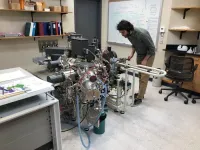(Press-News.org) E. coli bacteria may be far more capable at evolving antibiotic resistance than scientists previously thought, according to a new study published in Science on November 24.
Led by SFI External Professor Andreas Wagner, the researchers experimentally mapped more than 260,000 possible mutations of an E. coli protein that is essential for the bacteria’s survival when exposed to the antibiotic trimethoprim.
Over the course of thousands of highly realistic digital simulations, the researchers then found that 75% of all possible evolutionary paths of the E. coli protein ultimately endowed the bacteria with such a high level of antibiotic resistance that a clinician would no longer give the antibiotic trimethoprim to a patient.
“In essence, this study suggests that bacteria like E. coli may be more adept at evolving resistance to antibiotics than we initially thought, and this has broader implications for understanding how various systems in evolutionary biology, chemistry, and other fields adapt and evolve,” says Wagner, an evolutionary biologist at the University of Zurich in Switzerland.
Besides uncovering new and potentially worrisome findings about antibiotic resistance, the researchers’ work also casts doubt on a longstanding theory about fitness landscapes. These genetic maps represent how well an organism — or a part of it, like a protein — adapts to its environment.
On fitness landscapes, different points on the landscape represent different genotypes of an organism, and the height of these points represents how well each genotype is adapted to its environment. In evolutionary biology terms, the goal is to find the highest peak, which indicates the fittest genotype.
Prevailing theory regarding fitness landscapes predicts that in highly rugged landscapes, or those with multiple peaks of fitness, most evolving populations will become trapped at lower peaks and never reach the pinnacle of evolutionary adaptation.
However, testing this theory has been exceedingly difficult until now due to the lack of experimental data on sufficiently large fitness landscapes.
To address this challenge, Wagner and colleagues used CRISPR gene editing technology to create one of the most combinatorially complete fitness landscapes to date for the E. coli dihydrofolate reductase (DHFR) protein.
What they found was surprising. The landscape had many peaks, but most were of low fitness, making them less interesting for adaptation. However, even in this rugged landscape, about 75% of the populations they simulated reached high fitness peaks, which would grant E. coli high antibiotic resistance.
The real-world implications are significant. If rugged landscapes like this are common in biological systems, it could mean that many adaptive processes, such as antibiotic resistance, may be more accessible than previously thought.
The result could ultimately lead to a re-evaluation of theoretical models in various fields and prompt further research into how real-world landscapes impact evolutionary processes.
“This has profound implications not only in biology but beyond, prompting us to reevaluate our understanding of landscape evolution across various fields,” Wagner says. “We need to shift from abstract theoretical models to data-informed, realistic landscape models.”
END
Study provides fresh insights into antibiotic resistance, fitness landscapes
2023-11-23
ELSE PRESS RELEASES FROM THIS DATE:
Separating out signals recorded at the seafloor
2023-11-23
Blame it on plate tectonics. The deep ocean is never preserved, but instead is lost to time as the seafloor is subducted. Geologists are mostly left with shallower rocks from closer to the shoreline to inform their studies of Earth history.
“We have only a good record of the deep ocean for the last ~180 million years,” said David Fike, the Glassberg/Greensfelder Distinguished University Professor of Earth, Environmental, and Planetary Sciences in Arts & Sciences at Washington University in St. Louis. “Everything else is just shallow-water deposits. So it’s really important to understand the bias that might be present when we look ...
Dolomite crystals require cycles of saturation conditions to grow
2023-11-23
Addressing the long-standing “dolomite problem,” an oddity that has vexed scientists for nearly 200 years, researchers report that dolomite crystals require cycling of saturation conditions to grow. The findings provide new insights into how dolomite is formed and why modern dolomite is primarily found in natural environments with pH or salinity fluctuations. Dolomite – a calcium magnesium carbonate – is one of the major minerals in carbonate rocks, accounting for nearly 30% of the sedimentary carbonate minerality in Earth’s crust. However, despite its geological abundance, dolomite does not readily grow under laboratory conditions, ...
FLSHclust, a new algorithm, reveals rare and previously unknown CRISPR-Cas systems
2023-11-23
Using a new algorithm called FLSHclust (“flash clust”), researchers have discovered 188 rare and previously unknown CRISPR-linked gene modules – including a novel type VII CRISPR-Cas system – among billions of protein sequences. The approach and its findings provide novel opportunities for harnessing CRISPR systems and understanding the vast functional diversity of microbial proteins. CRISPR systems have been leveraged to develop a growing suite of novel biomolecular approaches, including CRISPR/Cas-mediated genome editing. The discovery ...
Extremely energetic cosmic ray detected, but with no obvious source
2023-11-23
An extremely energetic cosmic ray – an extragalactic particle with an energy exceeding ~240 exa-electron volts (EeV) – has been detected by the Telescope Array experiment’s surface detector, researchers report. However, according to the findings, its arrival direction shows no obvious source. Ultrahigh-energy cosmic rays (UHECRs) are subatomic charged particles from space with energies greater than 1 EeV – roughly a million times as high as the energy reached by human-made particle accelerators. Although low-energy cosmic rays primarily emanate from the sun, the origins of rarer UHECRs are thought to be related to the most energetic phenomena in the Universe, ...
Telescope Array detects second highest-energy cosmic ray ever
2023-11-23
In 1991, the University of Utah Fly’s Eye experiment detected the highest-energy cosmic ray ever observed. Later dubbed the Oh-My-God particle, the cosmic ray’s energy shocked astrophysicists. Nothing in our galaxy had the power to produce it, and the particle had more energy than was theoretically possible for cosmic rays traveling to Earth from other galaxies. Simply put, the particle should not exist.
The Telescope Array has since observed more than 30 ultra-high-energy cosmic rays, though none approaching the Oh-My-God-level energy. No observations have yet revealed ...
'Dolomite Problem': 200-year-old geology mystery resolved
2023-11-23
Images // Video
ANN ARBOR—For 200 years, scientists have failed to grow a common mineral in the laboratory under the conditions believed to have formed it naturally. Now, a team of researchers from the University of Michigan and Hokkaido University in Sapporo, Japan have finally pulled it off, thanks to a new theory developed from atomic simulations.
Their success resolves a long-standing geology mystery called the "Dolomite Problem." Dolomite—a key mineral in the Dolomite mountains in Italy, Niagara Falls, the White Cliffs of Dover and Utah's Hoodoos—is very abundant in rocks older than 100 million years, but nearly absent in younger ...
AI recognizes the tempo and stages of embryonic development
2023-11-23
Animal embryos go through a series of characteristic developmental stages on their journey from a fertilized egg cell to a functional organism. This biological process is largely genetically controlled and follows a similar pattern across different animal species. Yet, there are differences in the details – between individual species and even among embryos of the same species. For example, the tempo at which individual embryonic stages are passed through can vary. Such variations in embryonic development are considered an important driver of evolution, as they can lead to new characteristics, thus promoting evolutionary adaptations and biodiversity.
Studying the embryonic ...
Potential new target and drug candidate for Barth syndrome
2023-11-23
In a Nature Metabolism paper published today, researchers from the University of Pittsburgh detail a potential new target and a small-molecule drug candidate for treating Barth syndrome, a rare, life-threatening and currently incurable genetic disease with devastating consequences.
Barth syndrome affects about 1 in every 300,000 to 400,000 babies born worldwide. Those with the condition have weak muscles and hearts and experience debilitating fatigue and recurrent infections.
Pitt researchers discovered that faulty mitochondria are at least partially to blame, and identified a molecular culprit that could be targeted to potentially reverse the disease course in the future.
In ...
New therapy can treat rare and hereditary diseases
2023-11-23
A lot of research has been done over many decades on diseases that are widespread in large parts of the population, such as cancer and heart disease. As a result, treatment methods have improved enormously thanks to long-term research efforts on diseases that affect many people.
However, there are many diseases that affect just a handful people. These diseases often fly under the radar and are far less researched. They include quite a few rare, hereditary diseases, such as DOOR syndrome, which is ...
Y-chromosome and its impact on digestive diseases
2023-11-23
A major breakthrough in human genetics has been achieved with the complete decoding of the human Y chromosome, opening up new avenues for research into digestive diseases. This milestone, along with advancements in third-generation sequencing technologies, is poised to revolutionize our understanding of the genetic underpinnings of digestive disorders and pave the way for more personalized and effective treatment strategies.
The Y chromosome, the smallest of the human chromosomes, has long been shrouded in mystery due to its complex repetitive structure. However, recent advancements in sequencing technologies have enabled researchers to unravel the intricate details of this genetic ...


